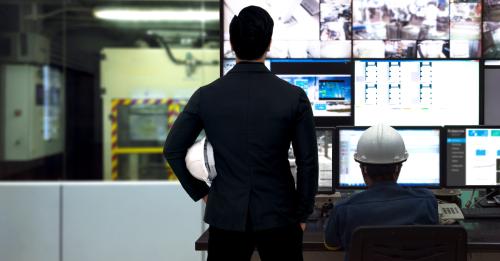The COVID–19 pandemic has negatively impacted a number of industries, perhaps none more than those engaged in food packaging, preparation, and service. The impact on the consumer end is well-discussed. Because of social distancing and other precautions related to employee and patron health and safety, many restaurants still operating do so well below capacity. Others have suspended operation; six in ten will not reopen. It is not, however, only restaurants and bars that have taken a hit. The meat-packing industry, for example, experienced a substantial number of infections—over 17,000 in April and May alone—that have led to shutdowns and supply disruptions, leading to shortages and increased prices paid by the public.
Concerns about the pandemic and the necessity of maintaining our food supply chains have pushed many businesses in these industries to increase their investments in automating or artificial intelligence technologies. In many cases, this is just an acceleration of preexisting trends. Tyson Foods, producer of roughly 20 percent of U.S. produced chicken, beef, and pork, invested more than $500 million in automation and related technological advancements in the last three years alone.
Of course, given that agriculture, food, and related industries employ a significant fraction of the workforce (10.9 percent of U.S. employment), movement toward automating technologies may be alarming to some. It is important to recognize, however, that the net effect of labor displacement depends on the nature of the new technology. It is instructive to survey which automating technologies are being adopted at different points of the food supply chain to better understand their impacts on this sector.
Automating Food Production and Distribution
The industrial agriculture and food (agri-food) industry is responsible for feeding the US and many of its trading partners. In a push towards greater efficiency and scale to meet the needs of the future, industry leaders have invested in robotics and automating technologies. Some key areas of development include automated irrigation, fertilizer, harvesting, and breeding systems. These process improvements are aimed at reducing production costs and conserving water, fuel, and fertilizer.
Many of these technologies are not only efficient, they are labor replacing. Spurred in part by the shortage of workers to pick fruit, some large commercial firms have employed harvesting robots that can cover the acreage of multiple workers. Given the impact of COVID–19 on borders and worker flows into and across the US, many firms have strong incentive to continue to invest in these technologies, further reducing the need for human labor. The advent of driverless tractors and sprayers will further reduce the need for large day-to-day staffs.
Further along the supply chain, we see an acceleration of automation adoption at distribution warehouses and grocery stores. Many warehouses have replaced traditional forklifts with automated guided vehicles (AGVS) that can perform a suite of tasks previously performed by multiple employees: unloading and loading trucks, and transporting large items across warehouse floors. They can also perform operations in harsh conditions like freezers and cold storage environments for longer periods.
Likewise, at grocery stores themselves, the pandemic has intensified technology use. We have seen more reliance on self-checkout cashiers and other types of kiosks that facilitate social distancing. But, as noted in the New York Times, “the grocery industry is leaning more on automation to free up employees to deal with the crush of demand during the pandemic.” Specifically, the story quotes a representative from Brain Corp, a firm that designs software used in automated floor cleaners, who states that autonomous floor care robot usage has risen in recent months to about 8,000 hours of daily work—a 13% increase from pre-pandemic use. This is work that “otherwise would have been done by an essential worker,” and thus allows these workers to engage in ostensibly more productive activities.
Robots in Restaurants
Automating technologies could be poised to fundamentally change food preparation and dining experience at some restaurants in the post-COVID era. According to an analysis by McKinsey & Company, nearly three quarters of food service and accommodations tasks could be automated. These span a broad number of tasks; industrial robots work in concert with AI, thermal scanners, and lasers to chop vegetables, grill hamburgers or other foods, or perform similar tasks. AI is now being used to improve cooking processes including optimizing recipes and ingredient selection. Similarly, at the front–end of restaurants, we could see substantial technology-driven change. In particular, we could see movement towards more automated service where voice- or facial recognition- activated cashiers could take orders and payments or assign tables.
There will likely be substantial heterogeneity across restaurants in this adoption as, unlike back–end operations, it is unclear how amenable potential diners will be to these technologies. As noted in a recent report issued by Oracle, four in ten consumers said they’d visit a restaurant less often if it used greeting robots. It is not just diners. 76 percent of restaurant operators say that its appealing to use robots for food quality checking, but nearly a quarter said they were near-sure that they were fully against some tech. This suggests that we might see sorting across restaurants depending on tastes and preferences for a technologically–driven experience, where there might be a premium associated with human customer service.
Policy Concerns
These technologies represent promising developments for maintaining and expanding our food supply chains. Policymakers may consider incentivizing technology expansion in the food industry as it continues to hold the promise of making production and supply processes safer, more resource efficient, and more productive, which will result in lower food prices and other positive spillovers to society.
There is potential peril as well. Many of these technologies are labor saving, meaning they replace the need for human labor to perform certain tasks. In some settings, these technologies will be complementary, freeing up labor to perform more productive tasks. But in most cases, adoption of these technologies will likely mean job and industry displacement for workers. At most risk, of course, are vulnerable middle– and low-wage workers in every stage of the food industry, from the fruit picker to the restaurant hostess. Given the number of workers employed in the food industry, such displacement may be highly disruptive to the lives of workers and their communities.
In anticipation, policymakers should be laying the groundwork to support displaced workers including: (1) forming partnerships with private sector employers to facilitate targeted retraining for workers that allows them to reenter the labor force quickly and with a stronger set of skills; and (2) establishing robust income and other social insurance support to allow them to effectively retrain.
COVID–19 is undoubtably accelerating change in the food industry. Many of these changes will likely lead to a safer, more efficient, and more robust food supply system in the face of this and potential future pandemics and related disasters. However, it is important to recognize that these changes often bring disruption to the well–being of workers in the industry and their families. It will be important for the policymakers to facilitate solutions aimed at mitigating potential harms to these workers and help them transition to this new economy.







Commentary
Automation from farm to table: Technology’s impact on the food industry
November 23, 2020